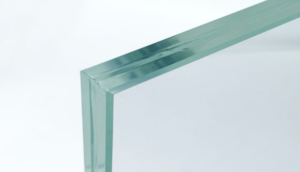The performance of the building facade not only depends upon the type of systems retaining the glass, but the infill products themselves. It is the responsibility of glazing contractors to understand performance expectations, the characteristics of the infill products and how these components work to meet the specified criteria. Laminated glass as an infill product has proven to be popular in modern day architecture due to its unique properties and is the subject of this technical bulletin.
Laminated glass consists of two or more lites of glass with one or more layers of polymer interlayers sandwiched between it. The glass and the interlayers are bonded through a high temperature/high pressure process, resulting in a versatile and useful product. The most common of these interlayers used in exterior glazing are Polyvinyl Butyral (PVB) and SentryGlas Plus (SGP).
Exterior façade laminated glass serves a variety of purposes, such as safety, forced-entry resistance, bullet resistance, impact resistance, blast mitigation and noise reduction. In addition, the interlayers inherently filter 99% of harmful UV radiation and provide protection again sun damage. The selection of interlayers is dependent upon the uses and characteristics of the product, as well as cost. Many of these uses rely upon AAMA, ASTM or UL testing standards utilizing specific products to validate the performance and effectiveness of assemblies.
PVB Interlayers
PVB is the most common interlayer used in laminated glass make ups. Its optical clarity, flexibility, ability to adhere to many surfaces and lower cost make it a primary interlayer for glass manufacturers.
Safety
Stock standard PVB laminated glass make ups combined with annealed glass allow glass processors and glaziers to cut the glass after lamination. This has become popular for urgent glass repairs that require a safety glass replacement. Laminating with heat strengthened glass or more complex PVB interlayers in the laminated make up is a common use but will generally have a longer lead time as it is custom made to specification and size.
Acoustics
PVB Interlayer is typically favored for use for sound resistance over SGP due to their lower costs, but assemblies can use differing products as noted in the table below. Specially developed acoustic interlayers are available that provide enhanced acoustical properties compared to laminates made with standard PVB. Tinting or translucence
Tinting or translucence
PVB Interlayer is typically favored for use in adding translucent because of its lower costs. In addition, PVB is as greater color availability and more flexible in the use of colored interlayers.
Other PVB considerations
It is not advisable to use common PVB interlayers where the laminate will have prolonged exposure to moisture as it can cause edge degradation or de-lamination over time. Also, in the event of breakage in both lites of glass, the PVB will not remain rigid and if not properly supported, may fold in the opening.
SGP Interlayers
SGP is an ion polymer film and compared to PVB, has twice the load-bearing capacity at the same thickness, one-fourth of the bending deflection, and five times the tear strength. Although more expensive, this rigidity better serves the following uses.
Structural load bearing applications
SGP interlayers offer the highest level of performance at specialty structural applications such as glass floors and stairs, which typically involve multiple layers of glass. Further, exterior and interior structural balustrades without adequate support frames also benefit from the use of these products as they maintain their protective barrier even after dual lite breakage.
Impact resistance
Laminated glass with SGP interlayer is commonly used for impact resistance caused by windborne debris in hurricanes. The rigidity of the interlayer is critical for resistance, but also important to maintain the glazed opening through the subsequent pressure cycles. Reference the latest ASTM test standards for the specific criteria.
Exterior edge exposed conditions
When laminated glass exposed edge applications are required externally such as railings and point fixed canopies, the SGP interlayer is a superior selection due to its ability to withstand weather conditions, resist moisture or delamination where other laminates cannot.
Other SGP considerations
As previously noted, SGP interlayer is typically more expensive compared to other laminates and has limited color availabilities. Also note that for certain applications relying on the structural integrity of the interlayer, engineering certification may be required.
PVB and SGP Interlayer Combinations
Forced-entry resistance / Bullet resistance
Laminated glass is common in forced entry-rated glass. Glazing make-ups may involve either type of interlayer, often times in combination with polycarbonates. ASTM and UL testing standards for Burglary Resistant Glazing Material are commonly used to evaluate the effectiveness of these assemblies.
Bulletproof glass is designed to slow, deform, and stop a bullet. The specific construction of each bullet-resisting glazing panel depends upon the anticipated threat level and can also involve the use of either interlayer in combination with polycarbonates.
Blast mitigation
Blast-resistance tends to have greater variation in use cases compared to other types of security glazing and involve a number of product solutions. First, there are many different types of blasts; different explosions created by different devices in different proximities have remarkably different effects. Second, blast rating standards are diverse, covering not just the effects of intentional detonations, but also unintentional detonations.
Blast-proof glass must also be able to protect people from the pressure wave that follows a bomb blast. In the event of a blast, shattered glass projectiles can cause extensive injuries, especially as the pressure wave can shatter glass beyond the immediate blast radius. Glazed blast-proof materials must eliminate glass shards and keep the system well-anchored to the wall. Many test standards and load criteria exist for blast ratings, requiring manufacture input and product certifications.
These narratives represent a basic understanding of laminated glass products used in facades. In the end, evaluating the product characteristics of laminated glass interlayers allows for the proper application and their ability to comply with the overall system’s performance requirements.
Click Here to View the Technical Bulletin in PDF.

